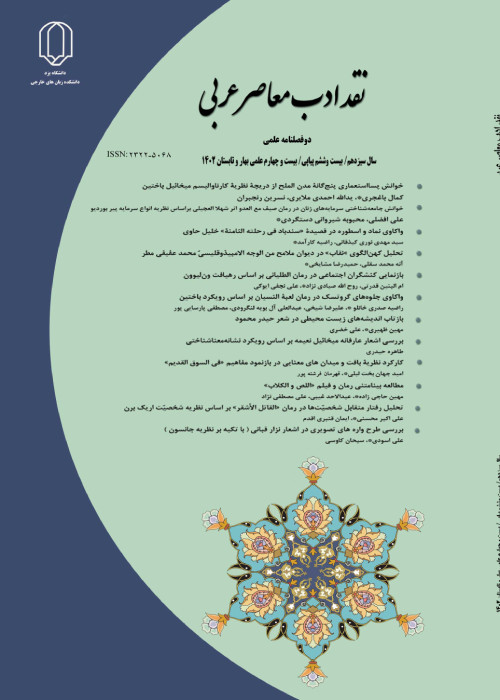The relationship between the sign and the modulus in non-verbal communication in the novel Ayyām maʻah
Semiotics, also called semiology, is the study of signs and sign-using behavior. It was defined by one of its founders, the Swiss linguist Ferdinand de Saussure, as the study of “the life of signs within society.” Although the word was used in this sense in the 17th century by the English philosopher John Locke, the idea of semiotics as an interdisciplinary field of study emerged only in the late 19th and early 20th centuries with the independent works of Saussure and the American philosopher Charles Sanders Peirce. Saussure treated language as a sign-system, and his work in linguistics supplied the concepts and methods that semioticians applied to sign-systems other than language. One such basic semiotic concept is Saussure’s distinction between the two inseparable components of a sign, namely the signifier, which is linguistically a set of speech sounds or marks on a page, and the signified, which is the concept or idea behind the sign. Saussure also distinguished parole, or actual individual utterances, from langue, the underlying system of conventions that makes such utterances understandable. It is this underlying langue that most interests semioticians. The interest in the structure behind the use of particular signs linked semiotics with the methods of structuralism, which sought to analyze such relations. Saussure’s theories are, thus, also considered to be fundamental to structuralism (especially structural linguistics) and poststructuralism. The relationship between language and emotions can be viewed from two viewpoints. First, language, in a broad sense, can be viewed as being emotive. Taking this view, it is commonly assumed that people, at least on occasions, have emotions, and that being emotional gains its own agency, impacting the communicative situation in a variety of ways. This can also take place extralinguistically (e.g. by facial expressions, body postures, proximity, and the like), in terms of suprasegmentational and prosodic features, and in terms of linguistic forms. In this view, language and emotion are two concurrent, parallel systems in use, and their relationship is due to the impacts of emotions on the performance of the language. Both of them share their functionality in the communicative process among people. If language is conceived of as merely representing the world of emotions and/or people's conceptualizations and understandings of the emotions, it offers an immediate access. Language, in this view, is transparent. However, if it is conceived of in one or another way as contributing to how emotions are understood, or even, to what emotions are, the relationship is not direct but mediated. As far as the narrative literature is concerned, the earliest philological studies of gesture show a strong interest in cultural history. They complemented contemporary writings in folklore, folk psychology and comparative linguistics that attempted to take the inventory of the gestures in various cultures, in particular those of the Greeks and Romans and of the European Middle Ages.
For any interaction with another person, we communicate with each other primarily through nonverbal channels. This occurs through multiple channels and is both strategic and non-strategic. This includes body language, voice tone, clothing and adornments, the environment, timing, and touch. For nonverbal communication, a single element such as choosing where to sit during a negotiation or meeting or perhaps a hand gesture can be viewed as having a minimal importance on the overall impact of the situation.
Personality is the manifestation of thoughts, feelings, and behaviors that make a person unique. It is believed that personality arises from within the individual and remains fairly consistent throughout life. While there are many different definitions of personality, most scholars focus on the pattern of behaviors and characteristics that can help to predict and explain a person's behavior. Traits and patterns of thought and emotion play important roles along with fundamental characteristics of personality. The major characteristics are as follows: a) Consistency: There is generally a recognizable order and regularity to behaviors. Essentially, people act in the same ways or similar ways in a variety of situations. b) Psychological and physiological features: Personality is a psychological construct, but research suggests that it is also influenced by biological processes and needs. c) Behaviors and actions: Personality not only influences how we move and respond to our environment, but it also causes us to act in certain ways. d) Multiple expressions: Personality is displayed in more than just behavior. It can also be seen in our thoughts, feelings, close relationships, and other social interactions. In the mentioned novel, there are several examples of cultural and social issues related to women that show an instrumental view of women. The social rights of women in this novel are not equal to those of men, and they are victims of what the patriarchal society figured out for them. Much of the behavior of the female characters in this novel arises from and is influenced by the cultural atmosphere of the society a few decades ago, whose cultural and social characteristics are revealed through what the society expect from women's behaviors, relationships and beliefs. The different women in this novel are the product of the world, i.e., thinking, culture, and upbringing of patriarchal societies. They have experienced emotions that are often formed under certain coercive conditions, and, in this novel, they move from tradition to modernity. They must both play the role of the beloved as a delicate creature and satisfy the opposite sex in the community and protecting their chastity and innocence in an atmosphere full of inequality as well as hidden verbal and physical violence. In this situation where the woman is still recognized as a veiled being, she is deprives of the possibility of direct communication with others. So, it makes the non-verbal communication of women more highlighted in the novel.
The following table shows the presence of non-verbal connotations in the novel Ayyām maʻah: total head hand position face 757 40 71 138 508 frequency Ayyām maʻah 100% 5% 10% 18% 67% percentage The relationship of the story characters to the feminine characters' non-verbal face-related signs has a high frequency. This indicates the importance of body language is in the relationships of the characters in the story. The high frequency of facial expressions in the novel is due to the fact that, in the non-verbal communication of the novel characters especially when the parties are women, facial expressions that include lip and mouth movements and eye gestures are more usable and visible. They are one of the main channels of messaging through which a huge amount of information is transmitted to the addressee in a relatively short time in the form of looks, laughter, crying and kissing. Regarding the importance of eye gestures in the non-verbal communication of the characters of the novel, it should be noted that the eye is the instance of the face and participates in revealing the hidden secrets of the person with other parts of the face. This is evident throughout the story and in the interpersonal relationships of the female characters, especially "Reem". Also, the non-verbal communication modules in the book contain more positive concepts to express satisfaction with the past, present happiness and hope for the future. This mood of the female characters in the story and their mostly confirmatory and peaceful personality are appropriate.
- حق عضویت دریافتی صرف حمایت از نشریات عضو و نگهداری، تکمیل و توسعه مگیران میشود.
- پرداخت حق اشتراک و دانلود مقالات اجازه بازنشر آن در سایر رسانههای چاپی و دیجیتال را به کاربر نمیدهد.




